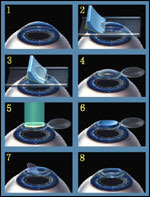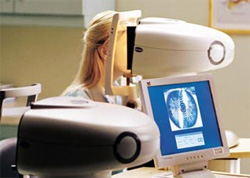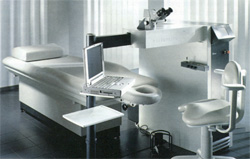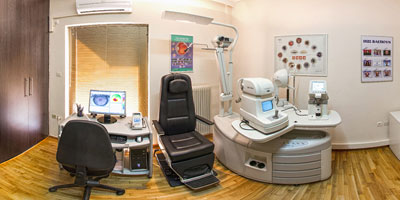Refractive Surgery
Refractive surgery and correction of myopia, hyperopia and astigmatism with excimer laser
Do you wear glasses or contact lenses? Do you depend on them but do not want to wear them anymore? Have you ever thought of your life without your glasses? Now you can.
The impressive progress in biomedical technology, in laser and ophthalmology allows us to correct myopia, hyperopia and astigmatism and to free ourselves of glasses and contact lenses. Results are amazing. Surgery is quick, painless and the patient leaves the operating room after a short while with no bandages.
Which are the refractive errors?
Refractive errors or ametropias are myopia, hyperopia, astigmatism and presbyopia.
In Myopia the anterior surface of the eye (the cornea) is too curved or the eye is too big or both. The image is formed in front of the retina (fundus) of the eye. far is blurry.
In hyperopia usually the eye is smaller. The image is formed behind the eye’s retina (fundus). Vision is blurry both near and far.
In astigmatism, the cornea’s curvature is not normal and so the image appears dull.
Presbyopia is considered a normal process of the eye which can be presented after the age of 40 and is attributed to gradual lack of adaptation for near vision. By consequence vision at near ranges is not good and the patient needs corrective glasses.
How are the refractive errors treated?
The classic means of correcting refractive errors is through glasses and contact lenses. For several reasons, many people do not wish to wear them either because they grew tired of them or for aesthetic/professional reasons or because they cannot tolerate contact lenses (intolerance, allergy, conjunctivitis). Refractive surgery is indicated for these individuals.
Refractive surgery includes all the techniques which allow us to correct refractive errors. It is performed by surgeons who are specialists in this area. We have accumulated nearly 20 years of experience, while progress in laser technology allows us to guarantee much better functional results.
Who can undergo surgery?
In theory every person with a refractive error can undergo surgery after consulting with the ophthalmologist. The following people are also good candidates for surgery:
- People who, for some reason, will not or cannot wear glasses (airline pilots, athletes, firemen, policemen etc.) or have problems with their contact lenses.
- Those who are over the age of 18 and their refraction has been stable for the last 12 months
- Those people who are interested in how they look and wish to have good quality vision without having to depend on glasses or contact lenses.
Laser Procedure
 The type of laser (excimer laser) is used to reshape the corneal surface in order to eradicate completely the refractive error. The technique which is mainly used today all around the world is laser-assisted in situ keratomileusis (LASIK) which represents a combination of microsurgery and laser.
The type of laser (excimer laser) is used to reshape the corneal surface in order to eradicate completely the refractive error. The technique which is mainly used today all around the world is laser-assisted in situ keratomileusis (LASIK) which represents a combination of microsurgery and laser.
LASIK is indicated for myopias of -1.00 to -10.00D, depending on the indications. With hyperopia and astigmatism there are more limitations (up to 6 degrees).
The surgeon creates and folds back a flap of the cornea. The laser reshapes the corneal stroma without damaging it. The flap is put back in place and surgery is completed. Anesthetic drops are used and the whole procedure is completely painless. Laser is applied for less than 1 minute, while the whole procedure lasts no longer than 5-10 minutes for both eyes. No protective lens or stitches are used and there is no postoperative pain or discomfort. In this way, eyesight is restored (after a few hours) and the possibility of postoperative haze of the cornea is minimized. The patient exits the operating room with no bandages and he/she no longer need glasses.
Results
Results with laser are very impressive. The target for the patient is to completely free him/herself of glasses and contact lenses. The achievement of +/- 0.50 diopters is considered a successful result. This can be achieved up to 99% of cases. Technology has evolved so much that today, this surgery is considered completely successful, reliable and very safe. Technology allows us to know preoperatively whether we are good candidates for this procedure and whether we can proceed with it safely. Not everyone can undergo this correction since there are contraindications. We are able to know this before the procedure in order to inform our patient of the possible result.
Preoperative examinations - Technology
 Prior to laser surgery, some preoperative ophthalmological examinations and measurements must be made. These examinations and measurements are highly important since the result depends directly on the accuracy and care with which they are made. It is important to know that for precise results we should not wear our contact lenses for at least 10 days prior to the day the examinations and surgery are undertaken. It is thus important to measure the myopia or hyperopia or astigmatism with the outmost accuracy first without and then with the use of eye drops which dilate the eye’s pupil.
Prior to laser surgery, some preoperative ophthalmological examinations and measurements must be made. These examinations and measurements are highly important since the result depends directly on the accuracy and care with which they are made. It is important to know that for precise results we should not wear our contact lenses for at least 10 days prior to the day the examinations and surgery are undertaken. It is thus important to measure the myopia or hyperopia or astigmatism with the outmost accuracy first without and then with the use of eye drops which dilate the eye’s pupil.
An ORBSCAN should be carried out which allows us to measure the corneal, to rule out cornea conditions which would represent a contraindication for this surgery (eg. keratoconus), and to measure its thickness. Pachymetry is very important to know in order to reshape the cornea, using the laser. If there is no enough tissue, then the procedure cannot be carried out.
 Dr. Tsioumas is using the state-of-the-art flying spot laser Wavelight Allegretto 400z.
Dr. Tsioumas is using the state-of-the-art flying spot laser Wavelight Allegretto 400z.
Alternative laser procedures
One of the alternative procedures for correcting viosion errors is PRK (photorefractive keratectomy). In PRK, no flap is folded back. The corneal epithelium is simply removed and the laser is directly applied. Before surgery is completed a therapeutic contact lens is placed on the eye until the epithelium heals. This technique can be used in cases where the corneal thickness does not allow lasik procedure.
What happens with high refractive errors?
In higher ametropias, myopias over 10-11 diopters and hyperopias over 4-5 diopters, our experience with laser over 15 years now, showed that best results are achieved with conventional procedures or through a combination of conventional procedures and laser. This is because in very high myopias and hyperopias corneal thinning is beyond certain limits and the safety of the eye is at jeopardy.
Very high ametropias are best treated surgically with the placement of permanent intraocular lenses (lenses placed inside the eye). There are special intraocular contact lenses which are placed either behind the iris (ICL) or in front of the iris (ARTISAN). The method has the advantage of being reversible. The lens can be removed if necessary, which is not the case with laser surgery. For better results, these techniques are combined with laser (bioptics) which is performed shortly after the placement of the intraocular lens and thus, the final visual acuity is achieved. The laser is used to guarantee results, correcting the rest of ametropia which could be remain after the placement of the lens.
If there is initial cataract already or/and the patient has high myopia and is of an older age, an alternative procedure is refractive lensectomy (clear lens extraction), that is the removal of the natural lens of the eye and the placement of a corrective intraocular lens. In great astigmatism, astigmatic incisions are made on the cornea, in order to change its pathological curvature. In pathological conditions, such as keratoconus, where astigmatism is very high, a corneal transplantation is indicated.
Complications
Refractive surgery procedures are among the safest procedures performed. As with every surgery, it entails the risk of possible (although rare) complications about which you should be informed.
a) Refractive complications
LASIK can lead either to overcorrection or undercorrection which are attributed to the differences among patients regarding healing of the cornea and other surgical parameters, leaving patients with myopia, hyperopia or astigmatism. In some cases (not all), the patient will have to wear glasses, contact lenses or to undergo an additional procedure.
Overcorrection rate : 1 in 100
Undercorrection rate : depends on the prescription the patient had, for example 4 in 100 for patients with 4D myopia, 8 in 100 for patients with 8D myopia.
b) Regression
This refers to the tendency of the eye to partly regress to the initial degree of the patient’s refractive error, following laser surgery. In most cases regression is small and it is taken into account when the surgeon plans the procedure. Often, patients presenting regression problems only need to wear glasses when driving at night.
Rate : 1 in 100
c) Loss of best corrected vision
A small number of patients presents a limited loss of visual acuity following laser surgery. This means that after your surgery you may not see as clearly as you did before surgery, even with glasses or contact lenses. In most cases, acuity is restored at a time period of 6 to 12 months.
Rate : 1 in 100
d) Night vision problems
Even before laser correction, many people have night vision problems or night time reflections (“halos”, “star explosions”) when using glasses or contact lenses.
Night-time reflections are common right after surgery and usually last for 3-4 months. From the moment both eyes have healed or 6 months after the operation, night-time reflections tend to diminish and vision will be restored to its initial state. However, you may still need glasses when driving at night.
Rate of severe night-time reflections : 1 in 50
e) Postoperative haze
What we call “haze”is a collagenoid protein which forms on your corneal surface after surgery, mainly after PRK. It cannot be seen with the naked eye. Despite the fact that it can be treated in most cases, usually it clears up gradually a few months after surgery.
Rate of serious cases : 1 in 1000
f) Infection
Perhaps the most serious complication. This probably represents the greatest risk in the first 48-72 hours after the surgery. You will be given antibiotic eye drops before and after surgery to avoid possible infection. Most serious infections can be treated. More rarely there are infections of the cornea (keratitis) which can affect the eye and consequently your vision.
Rate of serious infections : 1 in 5000
g) Epithelial ingrowth
This is observed when cells of the epithelial surface increase in number beneath the corneal flap, during the healing process. Epithelial ingrowth is more common in cases of injury or epithelium rupture. This situation is more often recorded with LASIK operations and also with long-term users of contact lenses. Despite the fact that most small areas of epithelial ingrowth only need to be monitored, large areas require lifting the flap and cleaning out the cells.
Rate : 1 in 100
h) Corneal flap complications
The most important advantages of the LASIK method have to do with the creation of a protective corneal flap. The corneal flap has to be clinically sufficient in quantity, thickness and size in order to have laser. Corneal flap complications during procedure is button hole or free cup and during the recovery period, include keratectasia and flap wrinkling.
While only 1% of patients present complications after the LASIK method, even fewer present serious flap complications.
Rate : 1 in 500
Conclusion. It is worth a try.
The doctor’s aim is to inform candidate patients and advise them on how good candidates they are, referring also to expected results and possible risks. It is also important for the doctor to acknowledge that each patient is unique. He/she should view each person differently during the refractive surgery assessment procedure. You must respect the limitations of refractive surgery. Not all patients are good candidates for surgery, but some are unwilling to accept this. It is more important to know who is not a right candidate for surgery. We must keep our expectations and beliefs within realistic limits. This is the key to successful refractive surgery. Your degree of satisfaction from surgery depends on whether your expectations were met to the full or greatest extent possible.
As far as cost is concerned, this depends on the clinic and the surgeon. Today cost is not prohibiting for patients. We must look at your surgery as an investment for life since the result does not change as time passes. Consider how much money you spend on contact lenses and their liquids each year or how much a good pair of glasses costs for which you have to change lenses every once in a while because of scratches or you have to buy a new frame because the old one is no longer in fashion?
However, before we proceed in any way we have to consult with an eye surgeon, specialist in such procedures.

